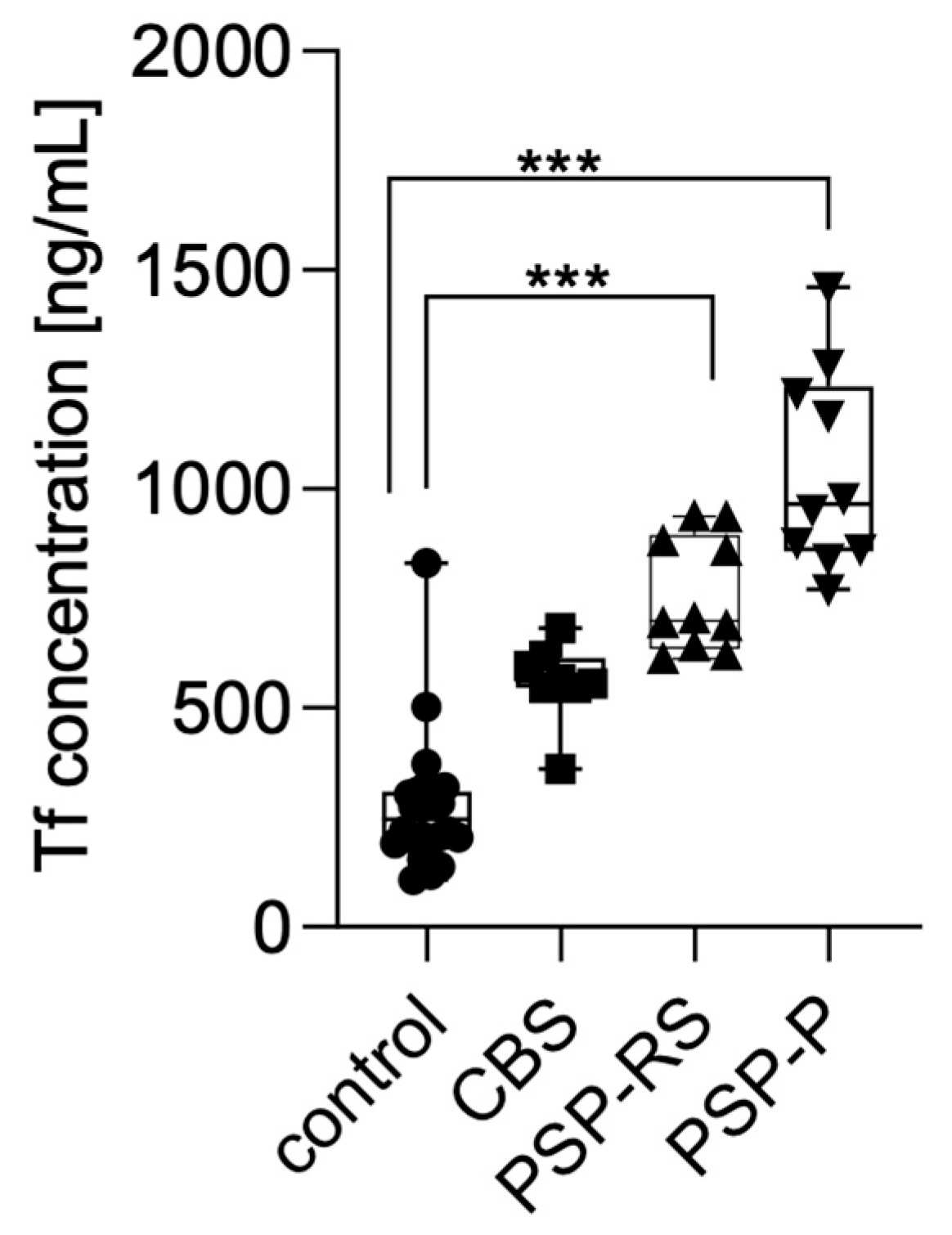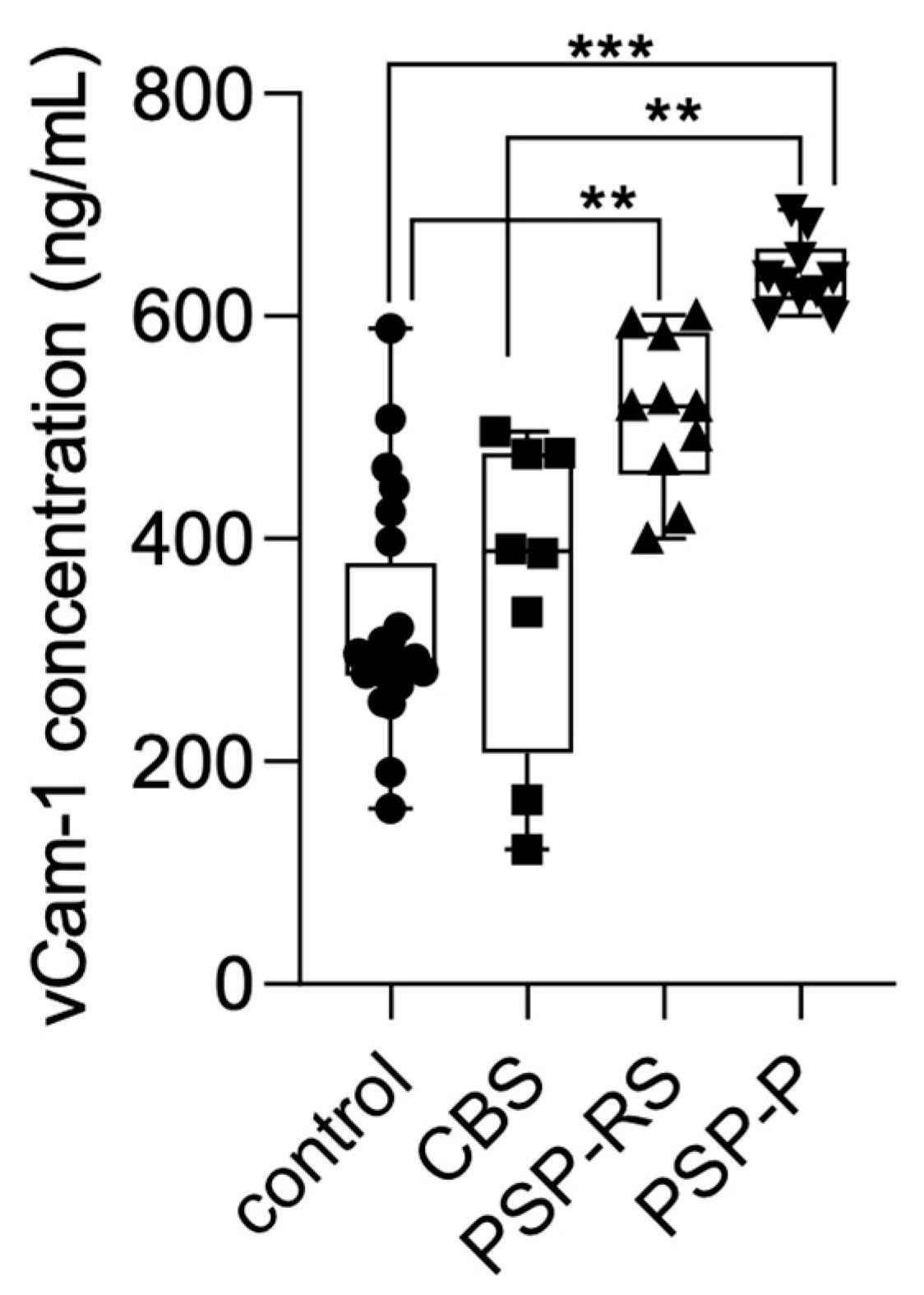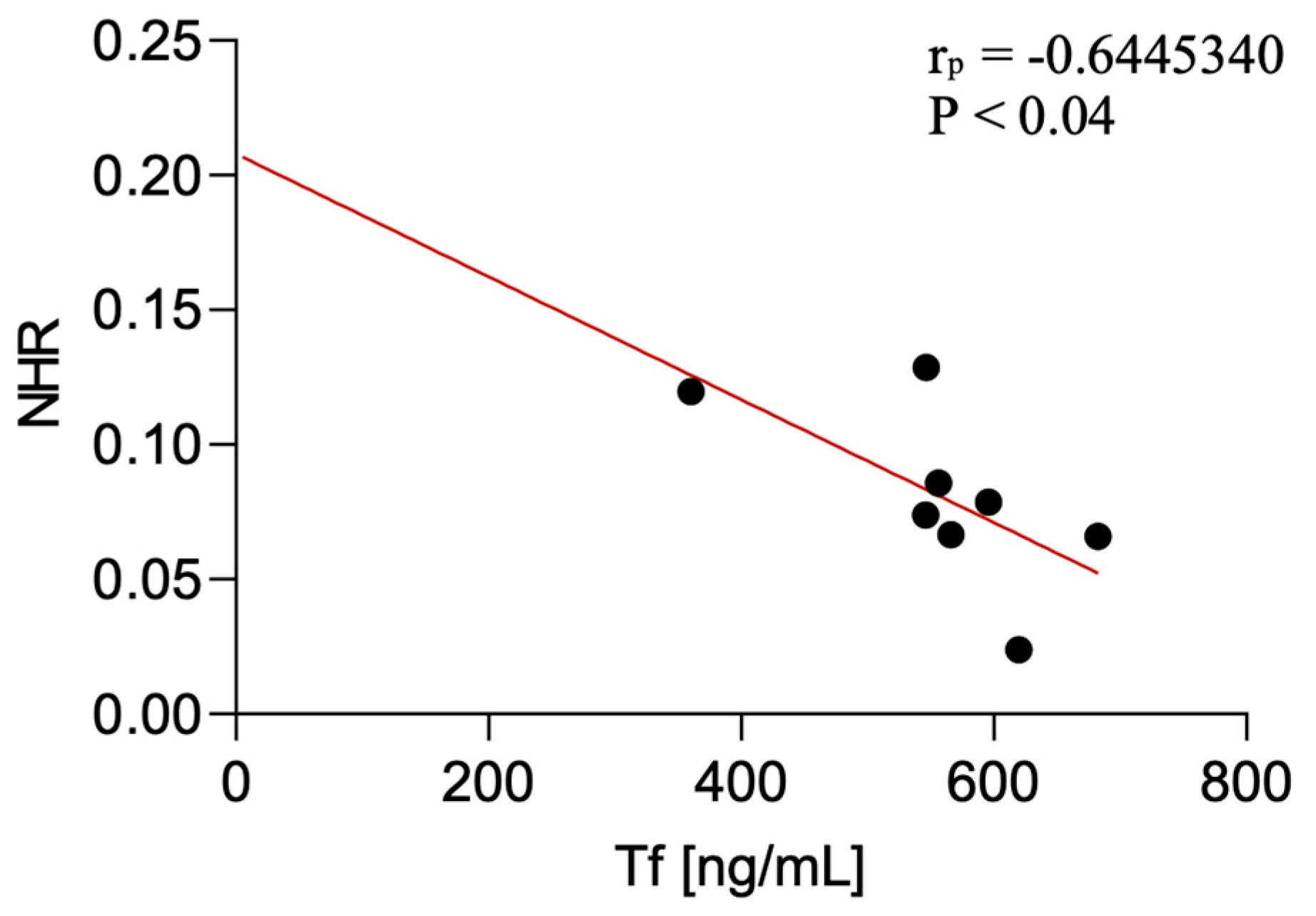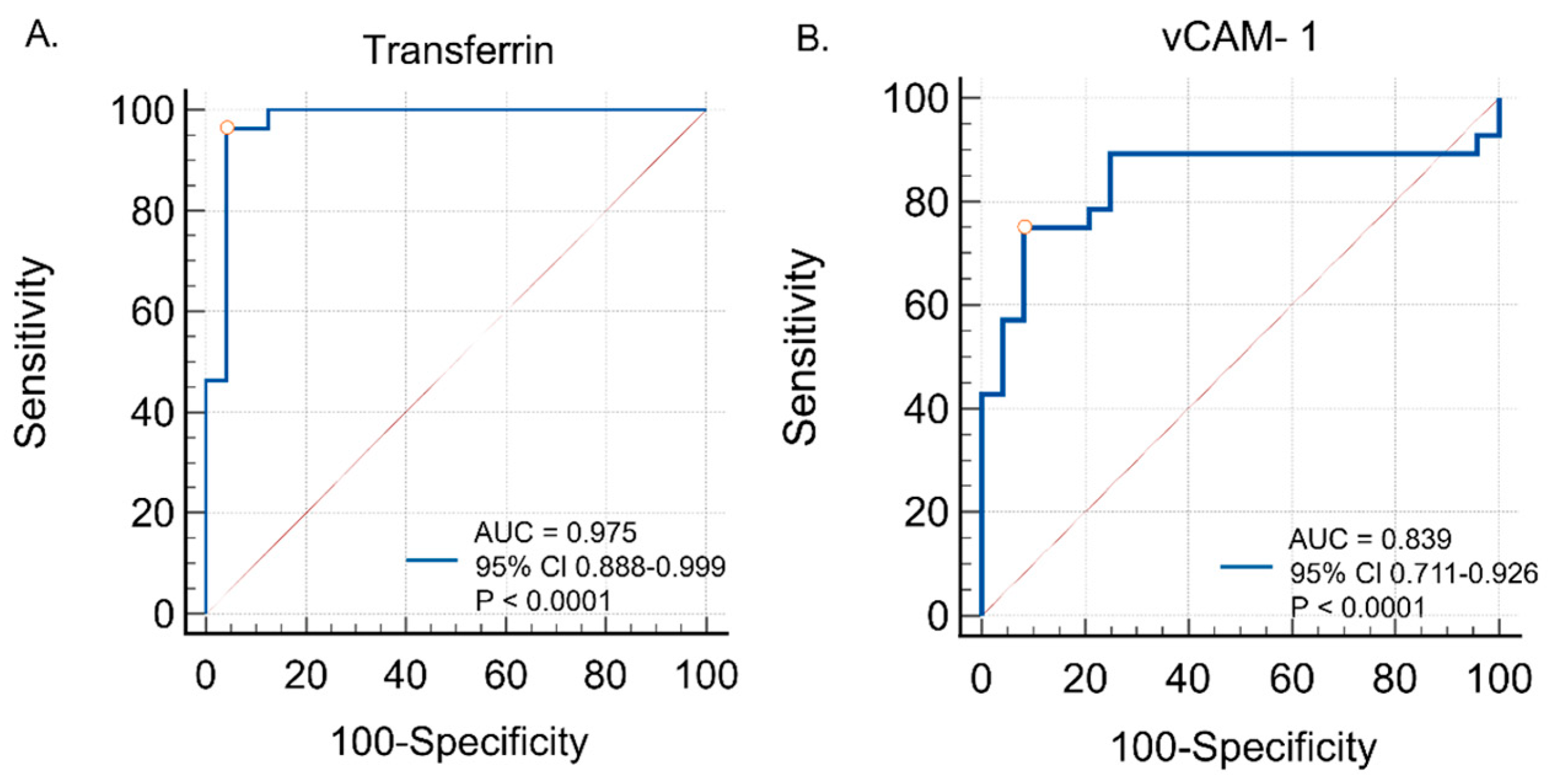Potential Role of Transferrin and Vascular Cell Adhesion Molecule 1 in Differential Diagnosis Among Patients with Tauopathic Atypical Parkinsonian Syndromes
Abstract
1. Introduction
2. Materials and Methods
- NLR—neutrophil-to-lymphocyte ratio;
- PLR—platelet-to-lymphocyte ratio;
- NMR—neutrophil-to-monocyte ratio;
- NHR—neutrophil-to-high-density lipoprotein ratio;
- MHR—monocyte-to-high-density lipoprotein ratio.
2.1. Patients’ Blood and Urine Collections
2.2. Vcam-1 and Transferrin Measurements in Patients
2.3. Statistical Analysis of Patient Data
3. Results
3.1. Demographic, Hematological, and Biochemical Characteristics
3.2. Inflammatory Ratios
3.3. Transferrin Levels in Serum
3.4. VCAM-1 Levels in Serum
3.5. Correlations with Inflammatory Ratios
3.6. Diagnostic Performance (ROC Curve Analysis)
4. Discussion
Limitations
5. Conclusions
Supplementary Materials
Author Contributions
Funding
Institutional Review Board Statement
Informed Consent Statement
Data Availability Statement
Conflicts of Interest
References
- Höglinger, G.U.; Respondek, G.; Stamelou, M.; Kurz, C.; Josephs, K.A.; Lang, A.E.; Mollenhauer, B.; Müller, U.; Nilsson, C.; Whitwell, J.L.; et al. Clinical Diagnosis of Progressive Supranuclear Palsy: The Movement Disorder Society Criteria. Mov. Disord. 2017, 32, 853–864. [Google Scholar] [CrossRef] [PubMed]
- Armstrong, M.J.; Litvan, I.; Lang, A.E.; Bak, T.H.; Bhatia, K.P.; Borroni, B.; Boxer, A.L.; Dickson, D.W.; Grossman, M.; Hallett, M.; et al. Criteria for the Diagnosis of Corticobasal Degeneration. Neurology 2013, 80, 496–503. [Google Scholar] [CrossRef] [PubMed]
- Dunalska, A.; Pikul, J.; Schok, K.; Wiejak, K.A.; Alster, P. The Significance of Vascular Pathogenesis in the Examination of Corticobasal Syndrome. Front. Aging Neurosci. 2021, 13, 668614. [Google Scholar] [CrossRef]
- Wareham, L.K.; Liddelow, S.A.; Temple, S.; Benowitz, L.I.; Di Polo, A.; Wellington, C.; Goldberg, J.L.; He, Z.; Duan, X.; Bu, G.; et al. Solving Neurodegeneration: Common Mechanisms and Strategies for New Treatments. Mol. Neurodegener. 2022, 17, 23. [Google Scholar] [CrossRef]
- McGeer, P.L.; Itagaki, S.; Boyes, B.E.; McGeer, E.G. Reactive Microglia Are Positive for HLA-DR in the Substantia Nigra of Parkinson’s and Alzheimer’s Disease Brains. Neurology 1988, 38, 1285. [Google Scholar] [CrossRef]
- Passamonti, L.; Rodríguez, P.V.; Hong, Y.T.; Allinson, K.S.J.; Bevan-Jones, W.R.; Williamson, D.; Jones, P.S.; Arnold, R.; Borchert, R.J.; Surendranathan, A.; et al. [11C]PK11195 Binding in Alzheimer Disease and Progressive Supranuclear Palsy. Neurology 2018, 90, e1989–e1996. [Google Scholar] [CrossRef]
- Williams, G.P.; Marmion, D.J.; Schonhoff, A.M.; Jurkuvenaite, A.; Won, W.-J.; Standaert, D.G.; Kordower, J.H.; Harms, A.S. T Cell Infiltration in Both Human Multiple System Atrophy and a Novel Mouse Model of the Disease. Acta Neuropathol. 2020, 139, 855–874. [Google Scholar] [CrossRef]
- Kaufman, E.; Hall, S.; Surova, Y.; Widner, H.; Hansson, O.; Lindqvist, D. Proinflammatory Cytokines Are Elevated in Serum of Patients with Multiple System Atrophy. PLoS ONE 2013, 8, e62354. [Google Scholar] [CrossRef]
- Brodacki, B.; Staszewski, J.; Toczyłowska, B.; Kozłowska, E.; Drela, N.; Chalimoniuk, M.; Stępien, A. Serum Interleukin (IL-2, IL-10, IL-6, IL-4), TNFα, and INFγ Concentrations Are Elevated in Patients with Atypical and Idiopathic Parkinsonism. Neurosci. Lett. 2008, 441, 158–162. [Google Scholar] [CrossRef] [PubMed]
- Jiang, L.; Zhong, Z.; Huang, J.; Bian, H.; Huang, W. Monocytohigh-Density Lipoprotein Ratio Has a High Predictive Value for the Diagnosis of Multiple System Atrophy and the Differentiation from Parkinson’s Disease. Front. Aging Neurosci. 2022, 14, 1035437. [Google Scholar] [CrossRef]
- Alster, P.; Madetko, N.; Friedman, A. Neutrophil-To-Lymphocyte Ratio (NLR) at Boundaries of Progressive Supranuclear Palsy Syndrome (PSPS) and Corticobasal Syndrome (CBS). Neurol. Neurochir. Pol. 2021, 55, 97–101. [Google Scholar] [CrossRef]
- Madetko, N.; Migda, B.; Alster, P.; Turski, P.; Koziorowski, D.; Friedman, A. Platelet-To-Lymphocyte Ratio and Neutrophil-Tolymphocyte Ratio May Reflect Differences in PD and MSA-P Neuroinflammation Patterns. Neurol. Neurochir. Pol. 2022, 56, 148–155. [Google Scholar] [CrossRef]
- Madetko-Alster, N.; Otto-Ślusarczyk, D.; Wiercińska-Drapało, A.; Koziorowski, D.; Szlufik, S.; Samborska-Ćwik, J.; Struga, M.; Friedman, A.; Alster, P. Clinical Phenotypes of Progressive Supranuclear Palsy—The Differences in Interleukin Patterns. Int. J. Mol. Sci. 2023, 24, 15135. [Google Scholar] [CrossRef]
- Leyns, C.E.G.; Ulrich, J.D.; Finn, M.B.; Stewart, F.R.; Koscal, L.J.; Remolina Serrano, J.; Robinson, G.O.; Anderson, E.; Colonna, M.; Holtzman, D.M. TREM2 Deficiency Attenuates Neuroinflammation and Protects against Neurodegeneration in a Mouse Model of Tauopathy. Proc. Natl. Acad. Sci. USA 2017, 114, 11524–11529. [Google Scholar] [CrossRef]
- Alster, P.; Otto-Ślusarczyk, D.; Kutyłowski, M.; Migda, B.; Wiercińska-Drapało, A.; Jabłońska, J.; Struga, M.; Madetko-Alster, N. The Associations between Common Neuroimaging Parameters of Progressive Supranuclear Palsy in Magnetic Resonance Imaging and Non-Specific Inflammatory Factors—Pilot Study. Front. Immunol. 2024, 15, 1458713. [Google Scholar] [CrossRef]
- Gomme, P.T.; McCann, K.B.; Bertolini, J. Transferrin: Structure, Function and Potential Therapeutic Actions. Drug Discov. Today 2005, 10, 267–273. [Google Scholar] [CrossRef] [PubMed]
- Hussain, R.I.; Ballard, C.G.; Edwardson, J.A.; Morris, C.M. Transferrin Gene Polymorphism in Alzheimer’s Disease and Dementia with Lewy Bodies in Humans. Neurosci. Lett. 2002, 317, 13–16. [Google Scholar] [CrossRef] [PubMed]
- Kim, K.W.; Jhoo, J.H.; Lee, J.H.; Lee, D.Y.; Lee, K.U.; Youn, J.Y.; Woo, J.I. Transferrin C2 Variant Does Not Confer a Risk for Alzheimer’s Disease in Koreans. Neurosci. Lett. 2001, 308, 45–48. [Google Scholar] [CrossRef] [PubMed]
- Singh, V.; Kaur, R.; Kumari, P.; Pasricha, C.; Singh, R. ICAM-1 and VCAM-1: Gatekeepers in Various Inflammatory and Cardiovascular Disorders. Clin. Chim. Acta 2023, 548, 117487. [Google Scholar] [CrossRef]
- Liu, Z.; Simard, M.J.; Huot, J. Endothelial MicroRNAs Regulating the NF-ΚB Pathway and Cell Adhesion Molecules during Inflammation. FASEB J. 2018, 32, 4070–4084. [Google Scholar] [CrossRef]
- Garton, K.J.; Gough, P.J.; Philalay, J.; Wille, P.T.; Blobel, C.P.; Whitehead, R.H.; Dempsey, P.J.; Raines, E.W. Stimulated Shedding of Vascular Cell Adhesion Molecule 1 (VCAM-1) Is Mediated by Tumor Necrosis Factor-α-Converting Enzyme (ADAM 17). J. Biol. Chem. 2003, 278, 37459–37464. [Google Scholar] [CrossRef] [PubMed]
- Troncoso, M.F.; Ortiz-Quintero, J.; Garrido-Moreno, V.; Sanhueza-Olivares, F.; Guerrero-Moncayo, A.; Chiong, M.; Castro, P.F.; García, L.; Gabrielli, L.; Corbalán, R.; et al. VCAM-1 as a Predictor Biomarker in Cardiovascular Disease. Biochim. Biophys. Acta (BBA)–Mol. Basis Dis. 2021, 1867, 166170. [Google Scholar] [CrossRef]
- Kong, D.-H.; Kim, Y.K.; Kim, M.R.; Jang, J.H.; Lee, S. Emerging Roles of Vascular Cell Adhesion Molecule-1 (VCAM-1) in Immunological Disorders and Cancer. Int. J. Mol. Sci. 2018, 19, 1057. [Google Scholar] [CrossRef]
- Lee, S.H.; Lyoo, C.H.; Ahn, S.J.; Rinne, J.O.; Lee, M.S. Brain Regional Iron Contents in Progressive Supranuclear Palsy. Park. Relat. Disord. 2017, 45, 28–32. [Google Scholar] [CrossRef]
- Pérez, M.J.; Carden, T.R.; Ayelen, P.; Silberstein, S.; Páez, P.M.; Cheli, V.T.; Correale, J.; Pasquini, J.M. Transferrin Enhances Neuronal Differentiation. ASN Neuro 2023, 15, 175909142311707. [Google Scholar] [CrossRef]
- Wendimu, M.Y.; Hooks, S.B. Microglia Phenotypes in Aging and Neurodegenerative Diseases. Cells 2022, 11, 2091. [Google Scholar] [CrossRef] [PubMed] [PubMed Central]
- Murakami, Y.; Saito, K.; Ito, H.; Hashimoto, Y. Transferrin Isoforms in Cerebrospinal Fluid and Their Relation to Neurological Diseases. Proc. Jpn. Acad. Ser. B 2019, 95, 198–210. [Google Scholar] [CrossRef]
- Casanova, A.G.; Vicente-Vicente, L.; Hernández-Sánchez, M.T.; Prieto, M.; Rihuete, M.I.; Ramis, L.M.; del Barco, E.; Cruz, J.J.; Ortiz, A.; Cruz-González, I.; et al. Urinary Transferrin Pre-Emptively Identifies the Risk of Renal Damage Posed by Subclinical Tubular Alterations. Biomed. Pharmacother. 2020, 121, 109684. [Google Scholar] [CrossRef]
- Perner, C.; Perner, F.; Gaur, N.; Zimmermann, S.; Witte, O.W.; Heidel, F.H.; Grosskreutz, J.; Prell, T. Plasma VCAM1 Levels Correlate with Disease Severity in Parkinson’s Disease. J. Neuroinflamm. 2019, 16, 94. [Google Scholar] [CrossRef] [PubMed]
- Yousef, H.; Czupalla, C.J.; Lee, D.; Chen, M.B.; Burke, A.N.; Zera, K.A.; Zandstra, J.; Berber, E.; Lehallier, B.; Mathur, V.; et al. Aged Blood Impairs Hippocampal Neural Precursor Activity and Activates Microglia via Brain Endothelial Cell VCAM1. Nat. Med. 2019, 25, 988–1000. [Google Scholar] [CrossRef]
- Kirsch, D.; Shah, A.; Dixon, E.; Kelley, H.; Cherry, J.D.; Xia, W.; Daley, S.; Aytan, N.; Cormier, K.; Kubilus, C.; et al. Vascular injury is associated with repetitive head impacts and tau pathology in chronic traumatic encephalopathy. J. Neuropathol. Exp. Neurol. 2023, 82, 127–139. [Google Scholar] [CrossRef] [PubMed] [PubMed Central]
- Nguyen, T.T.; Dev, S.I.; Chen, G.; Liou, S.C.; Martin, A.S.; Irwin, M.R.; Carroll, J.E.; Tu, X.; Jeste, D.V.; Eyler, L.T. Abnormal Levels of Vascular Endothelial Biomarkers in Schizophrenia. Eur. Arch. Psychiatry Clin. Neurosci. 2017, 268, 849–860. [Google Scholar] [CrossRef] [PubMed]
- Vallée, A. Neuroinflammation in Schizophrenia: The Key Role of the WNT/β-Catenin Pathway. Int. J. Mol. Sci. 2022, 23, 2810. [Google Scholar] [CrossRef] [PubMed]
- Majerova, P.; Michalicova, A.; Cente, M.; Hanes, J.; Vegh, J.; Kittel, A.; Kosikova, N.; Cigankova, V.; Mihaljevic, S.; Jadhav, S.; et al. Trafficking of Immune Cells across the Blood-Brain Barrier Is Modulated by Neurofibrillary Pathology in Tauopathies. PLoS ONE 2019, 14, e0217216. [Google Scholar] [CrossRef]
- Zhu, S.; Zhang, Y.; Li, C.; Deng, Z.; Yin, Y.; Dong, Z.; Kuang, L.; Li, C.; Hu, X.; Yin, T.; et al. Multiple Synergistic Anti-Aging Effects of Vascular Cell Adhesion Molecule 1 Functionalized Nanoplatform to Improve Age-Related Neurodegenerative Diseases. J. Control. Release 2025, 379, 363–376. [Google Scholar] [CrossRef]
- Martinez, A.E.; Weissberger, G.H.; Kuklenyik, Z.; He, X.; Meuret, C.; Parekh, T.; Rees, J.C.; Parks, B.A.; Gardner, M.S.; King, S.T.; et al. The Small HDL Particle Hypothesis of Alzheimer’s Disease. Alzheimer’s Dement. 2022, 19, 391–404. [Google Scholar] [CrossRef] [PubMed]
- Lee, S.; Martinez-Valbuena, I.; de Andrea, C.E.; Villalba-Esparza, M.; Ilaalagan, S.; Couto, B.; Visanji, N.P.; Lang, A.E.; Kovacs, G.G. Cell-Specific Dysregulation of Iron and Oxygen Homeostasis as a Novel Pathophysiology in PSP. Ann. Neurol. 2022, 93, 431–445. [Google Scholar] [CrossRef]
- Chahine, L.M.; Rebeiz, T.; Rebeiz, J.J.; Grossman, M.; Gross, R.G. Corticobasal syndrome: Five new things. Neurol. Clin. Pract. 2014, 4, 304–312. [Google Scholar] [CrossRef]





| Parameter | Control (n = 24) | PSP-P (n = 10) | PSP-RS (n = 10) | CBS (n = 8) |
|---|---|---|---|---|
| Age (years) | 66.9 ± 6.2 | 65.9 ± 9.2 | 67.3 ± 6.7 | 69.6 ± 5.4 |
| Neutrophils (×109/L) | 5.5 ± 2.1 | 5.1 ± 1.5 | 4.1 ± 1.4 | 3.19 ± 0.67 |
| Lymphocytes (×109/L) | 2.1 ± 0.8 | 1.9 ± 0.8 | 1.52 ± 0.5 | 1.59 ± 0.47 |
| Monocytes (×109/L) | 0.5 ± 0.2 | 0.52 ± 0.14 | 0.44 ± 0.13 | 0.39 ± 0.10 |
| Platelets (×109/L) | 252 ± 73.7 | 213.1 ± 33.6 | 213.5 ± 44.7 | 215.7 ± 56.7 |
| HDL (mg/dL) | 40.4 ± 23.1 | 50.3 ± 12.7 | 47.1 ± 11.8 | 44.5 ± 20.3 |
| VCAM-1 serum (ng/mL) | 322.7 ± 99 | 637.8 ± 32.0 | 472.4 ± 170.8 | 356.1 ± 142.9 |
| Transferrin serum (ng/mL) | 273.1 ± 147 | 1041.4 ± 227.3 | 742.8 ± 133.6 | 559.1 ± 92.7 |
| Ratio | Control (n = 24) | PSP-P (n = 10) | PSP-RS (n = 10) | CBS (n = 8) |
|---|---|---|---|---|
| NLR | 2.98 ± 1.32 | 2.92 ± 1.6 | 2.86 ± 1.04 | 2.23 ± 0.65 |
| PLR | 143.4 ± 71.2 | 127.3 ± 59.0 | 156.4 ± 65.2 | 155.9 ± 60.5 |
| MHR | 0.27 ± 0.13 | 0.01 ± 0.001 | 0.01 ± 0.004 | 0.01 ± 0.006 |
| NMR | 11.6 ± 8.5 | 9.1 ± 2.3 | 9.1 ± 2.4 | 8.62 ± 2.1 |
| NHR | 0.15 ± 0.09 | 0.10 ± 0.04 | 0.09 ± 0.02 | 0.08 ± 0.01 |
| Substance | Ratio | Biological Fluid | APS Subtype | Type of Correlation | Statistical Parameters |
|---|---|---|---|---|---|
| vCAM-1 | NLR | serum | CBS | negative | p < 0.03, rp = −0.739944 |
| Transferrin | NHR | serum | CBS | negative | p < 0.04, rp = −0.6445340 |
| Biomarker | AUC | 95% CI | p-Value | Optimal Cut-Off | Sensitivity/Specificity |
|---|---|---|---|---|---|
| Transferrin | 0.975 | 0.888–0.999 | <0.0001 | >503.0 | 96.4%/95.8% |
| vCAM-1 | 0.839 | 0.711–0.926 | <0.0001 | >463.9 | 75.0%/91.7% |
Disclaimer/Publisher’s Note: The statements, opinions and data contained in all publications are solely those of the individual author(s) and contributor(s) and not of MDPI and/or the editor(s). MDPI and/or the editor(s) disclaim responsibility for any injury to people or property resulting from any ideas, methods, instructions or products referred to in the content. |
© 2025 by the authors. Licensee MDPI, Basel, Switzerland. This article is an open access article distributed under the terms and conditions of the Creative Commons Attribution (CC BY) license (https://creativecommons.org/licenses/by/4.0/).
Share and Cite
Madetko-Alster, N.; Otto-Ślusarczyk, D.; Struga, M.; Chunowski, P.; Alster, P. Potential Role of Transferrin and Vascular Cell Adhesion Molecule 1 in Differential Diagnosis Among Patients with Tauopathic Atypical Parkinsonian Syndromes. Diagnostics 2025, 15, 2676. https://doi.org/10.3390/diagnostics15212676
Madetko-Alster N, Otto-Ślusarczyk D, Struga M, Chunowski P, Alster P. Potential Role of Transferrin and Vascular Cell Adhesion Molecule 1 in Differential Diagnosis Among Patients with Tauopathic Atypical Parkinsonian Syndromes. Diagnostics. 2025; 15(21):2676. https://doi.org/10.3390/diagnostics15212676
Chicago/Turabian StyleMadetko-Alster, Natalia, Dagmara Otto-Ślusarczyk, Marta Struga, Patryk Chunowski, and Piotr Alster. 2025. "Potential Role of Transferrin and Vascular Cell Adhesion Molecule 1 in Differential Diagnosis Among Patients with Tauopathic Atypical Parkinsonian Syndromes" Diagnostics 15, no. 21: 2676. https://doi.org/10.3390/diagnostics15212676
APA StyleMadetko-Alster, N., Otto-Ślusarczyk, D., Struga, M., Chunowski, P., & Alster, P. (2025). Potential Role of Transferrin and Vascular Cell Adhesion Molecule 1 in Differential Diagnosis Among Patients with Tauopathic Atypical Parkinsonian Syndromes. Diagnostics, 15(21), 2676. https://doi.org/10.3390/diagnostics15212676






